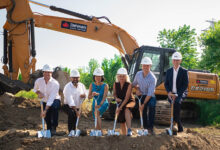Weather related damage causing home insurance rates to spike
Even if your home wasn’t hit by one of the severe weather events last year, chances are your insurance rates may have gone up because of flooding in a neighbouring city or forest fires on the other side of the country.
There’s been an increase of complaints, says Pete Karageorgos, the director of consumer and industry relations for Ontario with the Insurance Bureau of Canada. Angry homeowners have been calling the organization saying their insurance costs have soared.
A few condo corporations near Toronto’s core have seen spikes between 10 and 40 per cent, even though they’ve never had a claim.
That’s the case for Ryan Davey, president of a condo corporation near Liberty Village.
Claims reached $1.9B in 2018
Earlier this year, he says an increase of nearly 40 per cent came in from his corporation’s insurance provider.
“I think the reason we got was that it was due to higher payouts due to natural disasters and large rates of claims across the country,” said Davey.
According to a recent report from the Insurance Bureau of Canada (IBC), insured damage for floods, windstorms, ice storms and tornadoes reached $1.9 billion in 2018. Many experts say these weather events are becoming more intense and more frequent due to climate change.
Natural disasters are a big part of it, says insurance broker Nazim Charania, but claims are also much higher now because of how people are living.
“Now, more people are renovating and living in basements,” said Charania, who has worked in the insurance industry for two decades.
“Years ago, we didn’t have so many people with finished basements; they just lived upstairs and basements were open rooms used for storage. Now when basements flood, entire homes are lost.”
Century old infrastructure needs replacing
Aging infrastructure is another reason for increased insurance fees across the country, says Charania. In Toronto, where there’s been substantial population growth, roads, sewers, water mains and other century-old infrastructure can’t handle torrential downpours.
In 2018, strong showers and backed up sewers caused flooding not just near the waterfront, but also in High Park and North York, areas in Coun. Frances Nunziata’s ward.
“We’ve had severe flooding for years,” said Nunziata. “We have funding in the budget to do the infrastructure work but we’re now waiting for an environmental assessment [from the province].”
Earlier this week at Toronto city council, Nunziata put forward a motion to get the province to speed up environmental assessments in areas that fall under the Toronto and Region Conservation Authority, so that the necessary infrastructure work can be done to prevent properties from being destroyed when severe weather hits.
Nunziata says since the work has been delayed due to assessments, some of her constituents have “been denied insurance because of the number of times that they had to put in a [flood] claim.”
Improvements to infrastructure will help rates to a certain extent, says Karageorgos, but now the industry is reassessing numerous areas with better tools.
“There’s more flood data and maps … available. Companies are even offering enhanced coverages for overland water and flooding,” he said.
To get the best coverage, both Karageorgos and Charania say shopping around is the first step.
But Charania says if the difference between staying with your old provider or moving to a new one is just $20 a month, stay with your old one to get customer loyalty discounts in the future.
CBC








Redes Sociais - Comentários